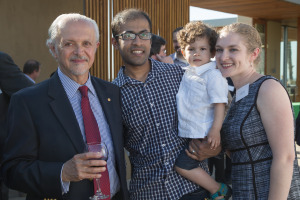Check out this 12 minute TEDx talk on air quality, climate, and health by Prof. Ilona Riiponen of Stockholm University.

Air pollution and Aerosol Information Resource for Educators and students
Check out this 12 minute TEDx talk on air quality, climate, and health by Prof. Ilona Riiponen of Stockholm University.
Pregunta: Me gusta mucho la clima buena del verano, pero no me gusta la contaminación del aire. ¿Por qué es la contaminación del aire peor en el verano? – T.S., New York, NY
Respuesta: Hay muchos factores que trabajan juntos para producir más contaminación del aire en el verano que en las otras estaciones. En el verano, las temperaturas son más altas y hay más luz solar. Estas cosas aceleran algunas reacciones químicas en la atmósfera que conducen al smog. Alta humedad mejora la química de partícula de aerosol. Las plantas también emiten más compuestos orgánicos volátiles (VOCs) naturales que se combinan con los contaminantes para que crear las partículas atmosféricas. Además, el aire tiende a ser más estancada cuando el clima está caliente.
¡Estamos muy contentos de anunciar el primer webinar en Español del American Chemical Society (ACS) y la Sociedad Quimica del Mexico!
El publico se puede asistir gratis.
Para mas informacion o para registrarse: http://www.acs.org/content/acs/en/events/upcoming-acs-webinars/energetico-sustentable.html
This long winter has had the AIRE team thinking about the amount of time we spend indoors, and the air quality there.
– These days, most people spend the vast majority of their time indoors (especially in the winter!). There is therefore high potential for exposure to pollutants indoors, i.e., at home or in the workplace.
– While what we think of as commonplace outdoor pollutants (e.g. car exhaust) may be less prevalent indoors than outdoors, other chemicals such as volatile organic compounds (VOCs) can be present at much higher concentrations indoors. Indoor VOCs may come from many sources including cleaning products, air fresheners, and new furniture. They can harmful to health on their own, or serve as precursors for the formation of aerosol particles.
– You have probably heard about secondhand smoke, which is the exposure of non-smokers by being around smokers. Thirdhand smoke can also be a problem. This occurs when nicotine, tar, and other harmful chemicals in tobacco smoke deposit on indoor surfaces like walls and carpets. People can be directly exposed to these chemicals through contact the surface, or reactions with gases like ozone may cause them to re-enter the gas phase.
We are looking forward to the warmer weather and more time in the fresh air outdoors!
Question: How far do pollutants from one place travel? Can we detect pollutants from far away places in our air here? – S.S., Seattle, WA
Answer: Some atmospheric gases and particles can travel over long distances, making air quality an international issue. Dust from dust storms in Africa and China regularly reaches the Western Hemisphere, and there is evidence that the long-range transport of pollution from Asia is raising the background levels of pollutants on the West Coast of the US. INTEX was a recent major collaborative NASA science campaign to study the intercontinental
transport of atmospheric pollutants.
Question: What are the health effects of pollution on humans? – L.I., Miami, FL
Answer: Poor air quality primarily affects the cardiovascular and respiratory systems. According to the EPA, exposure to particulate matter and ozone is associated with aggravated asthma, chronic bronchitis, reduced lung function, irregular heartbeat, heart attack, and premature death in people with heart or lung disease. For more information, see this site on the health effects of air pollution, maintained by Health Canada
El sitio web del Centro Mario Molina es un recurso maravilloso para información y noticias en Español sobre la calidad del aire, el cambio climático, y el desarrollo sustentable.
El Dr. Mario Molina es un químico conocido por todo el mundo por su trabajo en la química atmosférica. El Dr. Molina ganó el Premio Nobel de Química en 1995 por sus investigaciones sobre la descomposición del ozono estratosférico. Más recientemente, él ha estado trabajando para entender y mejorar la calidad del aire de la Ciudad de México y otras ciudades grandes, al iqual que el cambio climático. En el 2005 se fundó este Centro, que es “un puente de soluciones prácticas entre la ciencia y las políticas públicas en materia de energía y del medio ambiente para promover el desarrollo sustentable.”
http://centromariomolina.org twitter: @CentroMMolina

In honor of the 2014 Annual meeting of the American Association for Aerosol Research, happening this week in Orlando, FL, we are very excited to share with you this series of educational modules on the science and engineering of aerosols (airborne particles).
These materials were developed by Profs. Pratim Biswas, of Washington University St. Louis, and C. Y. Wu, of University of Florida, through a collaborative grant from the National Science Foundation. The modules are aimed at an introductory college level, and are excellent for supplementing course materials or learning on your own.
The modules: http://aerosols.wustl.edu/education/
The complete lecture series for an introductory course on Aerosol Science and Technology from WUStL is available FREE through ITunesU!: https://itunes.apple.com/us/course/id691280850
Additional information on this effort, and more resources: http://www.aerosols.wustl.edu/aaqrl/Education/mageep/index.html
Haga click aquí para ver esta publicada en Español
Next week (Oct. 12-14) is Earth Sciences Week. This is a great opportunity to get to know the educational programs offered by NASA. Our favorite is “S’COOL.” In this program, you learn about the different types of clouds, and you can make observations of the clouds in your area, record them, and report them back to NASA. By doing this, you can help NASA validate the performance of the CERES satellite. This satellite observes the same clouds you see from the ground, but from space!
Get to know the different types of clouds: Cloud Identification Chart (NASA)
Record your observations: Report Form
Report them to NASA: S’COOL Ground Observation Report